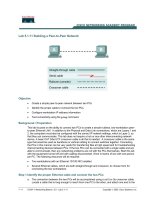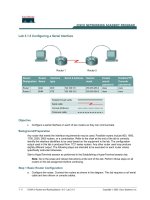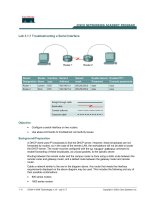UNIT 1. ONLINE COMMUNITIES: A NEW OPPORTUNITY LESSON 3. KEY FACTORS FOR A SUCCESSFUL ONLINE COMMUNITYNOTE pptx
Bạn đang xem bản rút gọn của tài liệu. Xem và tải ngay bản đầy đủ của tài liệu tại đây (1.09 MB, 12 trang )
1. Online Communities: a new opportunity - 3. Key factors for a successful online community - page 1
Information Management Resource Kit
Module on Building Electronic
Communities and Networks
UNIT 1. ONLINE COMMUNITIES:
A NEW OPPORTUNITY
LESSON 3. KEY FACTORS FOR A
SUCCESSFUL ONLINE COMMUNITY
© FAO, 2006
NOTE
Please note that this PDF version does not have the interactive features
offered through the IMARK courseware such as exercises with feedback,
pop-ups, animations etc.
We recommend that you take the lesson using the interactive courseware
environment, and use the PDF version for printing the lesson and to use as a
reference after you have completed the course.
1. Online Communities: a new opportunity - 3. Key factors for a successful online community - page 2
At the end of this lesson, you will be able
to:
• identify the critical social, cultural,
technical, environmental and
organizational factors that influence the
success of the online community building
process.
Objectives
The Online Interaction Iceberg
The Online Interaction Iceberg
Introduction
Think of an iceberg. Only a small
part shows above the water. In
online communities:
•the tools and technology are
the top of the iceberg; and
•the social/cultural, and
organizational/environmental
factors are the bigger, unseen
piece “below the visible water
line!”
In this lesson you will explore
these factors, starting with social
and cultural.
It is easy to think about online community from the technical point of view. Of course
Internet access and the appropriate software are critical. But there are many more
factors that influence the success of an online community. Most of them are
non-technical, but often less apparent.
1. Online Communities: a new opportunity - 3. Key factors for a successful online community - page 3
Social and cultural factors
Community is a social interaction between people.
That is why it is profoundly influenced by the social and cultural factors within the
community.
These factors focus on the interactions between individuals. Let’s take a look at some of
these factors such as the following…
• Identity
• Membership
• Culture
• Language
• Attention
• Power and Control
Social and cultural factors
• Identity
• Membership
• Culture
• Language
• Attention
• Power and Control
In the online world, our identity is less visible. How we “show up” to others depends on
how the community is designed. The most obvious way someone’s identity shows up
is by their e-mail address or login name for a Web site. But these may not always
be the person’s real name and people can hide their names.
What does it mean in terms of communication and trust building?
Sometimes people’s identities are based just on the words they share on an e-mail list.
This can be good for focusing on content, but challenging for forming relationships.
Some communities develop practices around
telling more about themselves or creating
online directories where pictures and
biographies are posted.
How much time you spend supporting
identity and the development of
relationships depends on the purpose of
your community.
Identity and relationships are important:
• more in long-term communities; and
• less for short-term events.
1. Online Communities: a new opportunity - 3. Key factors for a successful online community - page 4
Social and cultural factors
Listing the members can be useful,
particularly when the list includes other
information about the member such as
contact information, organization, interests
and location.
Another perspective on membership is if and
how you foster a feeling of community, group
and ownership. Sometimes you simply want
to facilitate interactions among individuals.
Other times, that “feeling of group” is critical.
These suggest different design approaches.
Defined membership is a way of creating boundaries around an online community. A
community can also be open to anyone.
In our face-to-face (F2F) communities, we can usually point to who belongs to what. Online it
is much harder to see, so one of the social dynamics is to define membership. This
may mean:
• making an online community closed to only those who belong (meaning only they have
access to the e-mail list or Web site); or
• attach some symbol of membership in communities that are open to public view.
• list the members.
• Identity
• Membership
• Culture
• Language
• Attention
• Power and Control
Social and cultural factors
Surfacing and sharing cultural preferences and norms can help a community adjust
and find ways that work for the members rather than imposing one culture upon the
whole community.
Because the Internet can allow us to connect with people outside of our culture, it is
important to consider the effects of bringing together people from diverse cultures.
We can benefit from the richness of different cultures, but we also have to find ways of
bridging our different styles and practices. Some cultures are formal, some less
formal. Some are attentive to relationship, others to task, and others to time. This
provides the benefits of diversity, but can also lead to misunderstandings.
• Identity
• Membership
• Culture
• Language
• Attention
• Power and Control
1. Online Communities: a new opportunity - 3. Key factors for a successful online community - page 5
Social and cultural factors
English has been the predominant language
of the Internet, but that is rapidly changing.
Still, diverse groups most often work in one
or two languages at a time. There are groups
that work with multiple languages, but that is
both a time consuming and technologically
complex approach.
The end result is that often in global online
communities many or most members are
working in a second language. This suggests
attention to modeling simple language and
inclusion where possible of images that can
augment the text.
• Identity
• Membership
• Culture
• Language
• Attention
• Power and Control
Social and cultural factors
If it can be hard to get and hold
people’s attention face-to-face, it is
even harder online.
Making sure that your online
community provides value to
participants and respects their needs
and conditions helps hold attention.
If they are getting value, they will
pay attention.
Sometimes focusing on something
specific for a short period of time
helps draw in people’s attention and
can be useful in refocusing if it feels
like people are paying less attention.
• Identity
• Membership
• Culture
• Language
• Attention
• Power and Control
1. Online Communities: a new opportunity - 3. Key factors for a successful online community - page 6
Social and cultural factors
Communities often can’t be
“controlled” in the formal sense.
Online, if someone doesn’t like
what is happening, it is easy to
just disappear. So communities
must pay attention to:
• balancing control (keeping things
organized); and
• emergence (letting the
community evolve and grow).
Power and control are familiar issues offline. Online, however, where we can’t see each other’s
body language and tone, issues of power and control can feel more intense, even if not
intended.
Who “controls” the community’s technology may have more control in some ways. Who is a
fluent writer (fast typist, strong linguist, fast reader) may have more power than they might
have offline. The environment can change the dynamics of power and control.
One way to understand this is to be as explicit as you can in your communication and to
pay attention and intervene if the power gets out of balance, or the community gets either
too controlled or not controlled enough.
• Identity
• Membership
• Culture
• Language
• Attention
• Power and Control
Organizational and environmental factors
But most people in an online community
belong to other organizations and
communities, which can affect their online
community. They live in countries with laws.
They have their “ways of doing things” that
may vary among the members.
These organizational and environmental
factors can influence the behaviour and
outcome of the community. So paying
attention to the dynamics of the
organizations involved is useful.
In some sense, when you design or lead an
online community, you are stepping into the
role of organizational development.
What organizational influences are at play
can influence how best to help the
community reach it’s goals.
The social factors focus on how people participate with each other as individuals.
1. Online Communities: a new opportunity - 3. Key factors for a successful online community - page 7
Key factors for a successful online community
ORGANIZATIONAL AND ENVIRONMENTAL FACTORS:
SOME USEFUL QUESTIONS
• How does organizational power and control show up within and around the community? Does
one organization have more influence than another and will that impact our community?
• How will member organizations support or not support individual participation? (Will they give
them time to participate, support access, etc.)
• How does information and knowledge move within the community membership and their
organizations? Do some people hoard or protect information rather than share it because of their
organizational culture?
• What legal and political factors can impact the success or failure of the community? Is there a
law against using VoIP tools (voice over internet protocol) making it inadvisable for you to
choose that as a community tool? Are there laws in one member’s country about how children
can participate in online communities and will there be children involved? Are there restrictions
about how much advocacy a group can do that impact some of your members?
• How do socio-economic factors impact your community? What if some members can less afford
to spend time online than others? What if some are criticized at home for their involvement? How
can those people fully participate? How might this impact the sustainability of your community?
Organizational and environmental factors
Technical factors
Without the Internet and interaction software, online communities would not exist. So the
availability, cost and speed of Internet access are crucial.
The choice of tools, the way you choose to use them and how members are
supported in learning how to use them can influence a community’s success. There
will be more details later in the module but here are some general factors to consider:
• Access
• Potential tools and technologies
• Purpose before tool picking
• Training and Support
Let’s examine them in details…
1. Online Communities: a new opportunity - 3. Key factors for a successful online community - page 8
Technical factors
The first technological factor is often the
one that determines if you can have an
online community at all.
Online implies at least some Internet
access. You need to know if your
intended members have access, or if
some don’t, that you have alternative
mechanisms for participation, such as
printing online content to share offline,
CD ROMs, or blending online with F2F
interactions.
Use your imagination. But it is important
to not just use online community because
it is new or “cool.” Use it if it makes
sense!
Access
Potential tools and technologies
Technical factors
There are a variety of technological
tools. Some of them support certain
types of online group interactions
better than others.
Based on your assessment of the
social/cultural and
environmental/organizational
factors, you can determine WHAT
your community needs to do
together, and then pick the best
tool.
1. Online Communities: a new opportunity - 3. Key factors for a successful online community - page 9
Purpose before tool picking
Technical factors
Sometimes you will have only one
choice: e-mail. But often you have more
choices. It is important to let the
purpose drive your technology
choice, not let the technology drive the
purpose or the community.
One of the key distinctions in tools is if
you need interactivity or not:
• Delivery of information with no
feedback or changes does not require
interaction; on the contrary
• Creating new ideas, working together
and many forms of learning do.
Online communities and the tools associated with them benefit from interactivity.
Technical factors
What do you think static web pages are useful for?
Please select the answer of your choice (1 or more) and press
Check Answer.
Sharing information that does not change too frequently
Building new knowledge
Listing community purpose and guidelines
1. Online Communities: a new opportunity - 3. Key factors for a successful online community - page 10
Technical factors
Training and Support
Having the access and the tools is
just the first step towards actual
use.
Consider if your members will
need training and support using
the online tools.
These are very important aspects
and should be part of your
considerations.
Technical factors
When planning and designing for an online community for policy makers in national
ministries of health, which factors might be most important. Please order from most
important to least important.
Please order these items using the dropdown boxes and press “Check Answer”.
There will be up to 50 potential members of the community.
There are many different cultures involved in the group.
Not everyone is familiar with the tools that have preliminarily
been identified for the community. Some people are afraid of
looking incompetent.
Health policy issues in some national ministries is considered
confidential information that should not be leaked out until
finalized.
Some members don’t have desk top access to the Internet.
1. Online Communities: a new opportunity - 3. Key factors for a successful online community - page 11
Learning from each other
These can be shared with the IMARK
programme or other programmes designed to
support communities and particularly those
interested in supporting communities with ICTs,
such as the following:
• IICD
, International Institute for Communication
and Development;
• APC
, Association for Progressive Communication;
• OneWorld.net
, a civil society network online;
• The Communications Initiative
, a space for more
effective development communication practice;
• CIVICUS
, World Alliance for Citizen Participation.
Online community building is a relatively new practice, so learning from each experience
and from each other is very important. It is very helpful to write up and share what you
learn and to engage with other community builders. A simple report on what you did,
why you did it and what happened can be a powerful contribution to other communities.
Learning from each other
There are groups and communities that are Communities of Practice that focus on skills
for designing and facilitating online communities. These are a great place to learn about
supporting an online community. You can also contribute back the lessons you’ve learned.
Some of these include:
• World Bank Site on Running E-Discussions;
• International Institute for Communications
Development;
• Bellanet
;
• KM for Development
;
• The Online Facilitation List
;
• The Emoderator's List
; and
• Making the Net Work
.
1. Online Communities: a new opportunity - 3. Key factors for a successful online community - page 12
Summary
• Online communities have created an opportunity for individuals
who are widely dispersed to “connect” and accomplish goals
together in new ways.
• Although facilitated by technology, these communities are
profoundly influenced by social, cultural, environmental,
organizational and technical factors.
• The social and cultural factors that mostly influence a community
are: Identity, Membership, Language, Attention, Power and
Control.
• Some general technical factors to consider are: Access, Potential
tools and technologies, Purpose before tool picking, Training and
Support.
If you want to know more…
Online resources
• Bernal, V. (2001) “Building Online Communities: Transforming Assumptions Into Success”
/>• McQueen, R.J. (1995), Electronic group communication for cultural support: Maori electronic networking in
New Zealand. Proceedings of the 1995 Pan Pacific Conference on Information Systems, Chuan, C.H. and
Dhaliwal, J.S. (Eds), pp. 371-373. [Publisher: Department of Decision Sciences National University of
Singapore, Singapore] />• Sorbello, E. “Virtual Communities - Social Interaction” ia-
culture.org.au/index.php/Online_Social_Interaction_-_The_Virtual_Community
• Wellman, B. (2002) “Little Boxes, Glocalization, and Networked Individualism” Pp. 10-25 in Digital Cities II:
Computational and Sociological Approaches, edited by Makoto Tanabe, Peter van den Besselaar and Toru
Ishida. Berlin: Springer, 2002. />• Wellman, B. (2005) "Connecting Community: On- and Off-line"
/>• White, N. (1999, 2005) “How Some People Have Tried to Describe Community”
/>• White, N (various) “Online Community Toolkit” />• White, N. (2003) “Designing Online Events” />• Wikipedia, Definition of “Social Networks” />• Wilcox, D. (1997) “An (archive) toolkit for online communities”
/>









